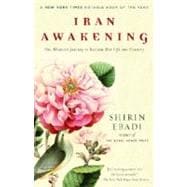
Note: Supplemental materials are not guaranteed with Rental or Used book purchases.
Purchase Benefits
What is included with this book?
| Prologue | p. xiii |
| A Tehran Girlhood | p. 3 |
| Discovering Justice | p. 15 |
| The Bitter Taste of Revolution | p. 39 |
| Iran at War | p. 57 |
| War of the Cities | p. 71 |
| Strange Times, My Darling | p. 93 |
| From the Living Room to the Courtroom | p. 112 |
| Terror and the Republic | p. 128 |
| An Experiment in Hope | p. 142 |
| A Conscientious Prisoner | p. 156 |
| In the Shadows of Reform | p. 179 |
| The Nobel Prize | p. 200 |
| Epilogue | p. 209 |
| Afterword | p. 217 |
| Acknowledgments | p. 221 |
| Sources | p. 223 |
| Index | p. 225 |
| Table of Contents provided by Ingram. All Rights Reserved. |
The New copy of this book will include any supplemental materials advertised. Please check the title of the book to determine if it should include any access cards, study guides, lab manuals, CDs, etc.
The Used, Rental and eBook copies of this book are not guaranteed to include any supplemental materials. Typically, only the book itself is included. This is true even if the title states it includes any access cards, study guides, lab manuals, CDs, etc.
Excerpted from Iran Awakening: One Woman's Journey to Reclaim Her Life and Country by Shirin Ebadi, Azadeh Moaveni
All rights reserved by the original copyright owners. Excerpts are provided for display purposes only and may not be reproduced, reprinted or distributed without the written permission of the publisher.